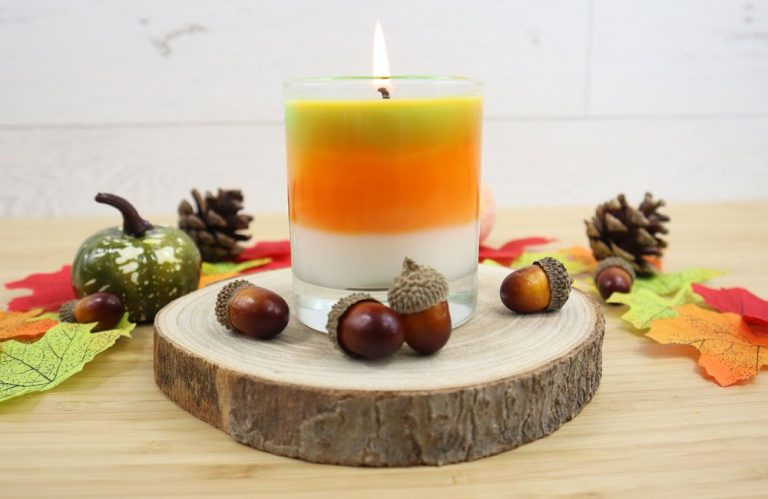What Does It Mean When A Candle Is A Soy Blend?
What Are Soy Blend Candles?
Soy blend candles refer to candles made from a mixture of soy wax and other waxes, most commonly paraffin wax. While 100% soy wax candles contain only soy wax, soy blend candles contain a blend of soy wax and anywhere from 10% to 80% other waxes like paraffin (source).
The soy wax used in these blended candles is still derived from soybeans. However, other waxes are incorporated to modify the properties of the candle. Adding paraffin wax makes the candle harder and allows it to hold its shape better. The blend aims to balance the benefits of soy wax with the helpful properties of other waxes.
Many candle makers prefer to work with a soy blend rather than 100% soy wax. The blend allows them to customize the burn, scent throw, and texture. While 100% soy wax remains popular for its natural ingredients, soy blends can result in candles that burn longer and hold up better to heat. Ultimately, soy blend candles still contain a high percentage of soy but with modifications from supplemental waxes.
Benefits of Soy Blend Candles
Soy blend candles provide several key benefits over traditional paraffin wax candles:
Soy candles burn longer – Soy wax has a lower melting point than paraffin, so it liquifies into oil more slowly as the candle burns. This allows the candle to burn longer before the wax pool dries out.
Cleaner burn – Soy wax comes from a renewable, plant-based source. Paraffin is a petroleum byproduct. When burned, paraffin wax releases compounds like toluene and benzene. Soy wax has a much cleaner burn.
Cost effective – Though more expensive than paraffin up front, soy candles provide more hours of burn time per candle. This makes them more cost effective in the long run. Soy wax is also easy to reuse and repurpose as compared to paraffin.
Common Blend Ratios
Soy blend candles can contain varying ratios of soy wax to other waxes like paraffin. Some common blend ratios include 51% soy wax blended with 49% paraffin, although the exact blend ratio is often proprietary to the candle maker. Other blends may contain as little as 10% or 20% soy wax mixed with mostly paraffin or other waxes. The ratio impacts the burn, scent throw, and other properties.
Soy Wax Benefits
Soy wax offers several benefits that make it a popular choice for candle making. Here are some of the main advantages of soy wax:
Soy wax is made from soybean oil, which is a renewable and sustainable resource. Soybeans are grown annually, so soy wax can be produced indefinitely without depleting limited resources.
The natural molecular structure of soy wax allows it to hold fragrances very well, giving soy candles excellent hot and cold scent throw. The wax helps diffuse fragrances evenly when burning and also when not lit. This results in strong, consistent aroma from soy candles.
Since soy wax is made from a plant-based oil, it’s considered a natural wax. Many people prefer soy candles because they burn cleaner than paraffin wax which is made from petroleum. Soy wax produces less soot and releases smaller amounts of toxins when burning.
Other Waxes in Blends
Two of the most common waxes blended with soy wax are paraffin and beeswax:
Paraffin – a petroleum-based wax – is often blended with soy wax to improve fragrance throw and make candles burn longer. Paraffin is inexpensive and readily available. However, it is not a natural product and emits more smoke and soot when burning compared to soy wax. Typical paraffin-soy blends contain anywhere from 30-70% paraffin wax.1

Beeswax is a natural wax made by honey bees. When blended with soy wax, beeswax helps make candles harder, improves burn time, and gives a subtle natural honey aroma. Beeswax also naturally contains vitamin A. However, beeswax candles are more expensive since beeswax is in limited supply. Beeswax typically makes up 5-30% of a soy wax blend.2
How Soy Blend Candles Are Made
The process of making soy blend candles involves mixing soy wax with other waxes like paraffin or beeswax in varying ratios depending on the properties desired. According to CandleScience, common soy wax blend ratios are 10-90% soy wax, though many aim for at least 50% soy wax content.
Once the wax blend is created, fragrance and dye are added to create the desired scent and color for the candle. Typical usage rates are 6-12% fragrance and less than 1% dye. The wax is then heated to a liquid state before being poured into containers or molds to set.
Most soy candle makers carefully control the temperature of the wax and let it cool slowly to prevent frosting and enable an even burn. The soy wax blend gives the candles a smooth surface and helps the fragrance throw. The end result is a natural, clean-burning candle.
Testing and Standards
Candle manufacturers in the United States must adhere to safety standards and regulations set by ASTM International and enforced by the Consumer Product Safety Commission (CPSC). The main standard for candle safety is ASTM F2417, “Standard Specification for Fire Safety for Candles.”
ASTM F2417 establishes requirements for candle performance to help minimize ignition of materials by the candle flame. It specifies tests for candle stability, end of useful life, resistance to extinction, and other safety criteria. The standard also provides guidelines for proper candle labeling to inform consumers of any safety risks.
One key test within ASTM F2417 is the “candle burn test,” which evaluates a candle’s burning rate, pool of liquid wax, and capability to self-extinguish if tipped over. Manufacturers perform burn tests periodically during production and retain results for auditing. Burn testing helps ensure soy blend candles meet limits for safe operation.
In addition to burn testing, ASTM standards cover scratch testing of candle glass containers (ASTM C1053), candle fire safety labeling (ASTM F1972), and more. Following ASTM guidelines is critical for regulatory compliance and delivering safe, high-quality candles to consumers (ASTM Industry Standards, Candle Safety Standards and Regulations in the US, Candle Safety Testing).
Cost Comparison
When it comes to cost, soy blend candles tend to be more expensive than paraffin wax candles but cheaper than pure beeswax candles. According to market research, soy wax costs around $5 per pound while paraffin wax is closer to $2 per pound. Beeswax, on the other hand, can cost $15-20 per pound or more depending on the source and quality.
The reason soy blends cost more than paraffin is because soy wax is derived from soybeans which are a more expensive raw material. Soy wax is also more labor intensive to produce. However, many candle makers and consumers feel the higher cost is worth it for soy’s renewable, natural source and biodegradable properties compared to petroleum-based paraffin.
While beeswax candles are considered the highest quality, their high cost puts them out of reach for many. Beeswax is expensive because it must be harvested directly from beehives in small quantities. Soy blends allow candle makers to offer a high quality, primarily natural product at a more affordable price point than pure beeswax.1
Environmental Impact
When it comes to the environmental impact, soy blend candles tend to be more sustainable than candles made from paraffin wax. Paraffin is a petroleum byproduct, so its production and use contributes to fossil fuel consumption. Soy, on the other hand, is a renewable crop that can be grown year after year (https://www.lalueurcandles.com/blogs/blog/are-candles-bad-for-the-environment).
That said, some concerns have been raised about the sustainability of growing soy, especially in places like the Amazon where rainforest is being cleared for soybean farms. However, most soy used in candles in the U.S. is grown domestically. When sourced responsibly, soy has less environmental impact than paraffin (https://suffolkcandles.co.uk/blogs/candles/is-soy-wax-eco-friendly-and-sustainable-lets-find-out-the-truth).
Additionally, soy blend candles burn cleaner than paraffin candles. Paraffin produces more soot, which can stain walls and emit carcinogens. The vegetable-based waxes in soy blends produce less soot and emit less fumes (https://www.lalueurcandles.com/blogs/blog/are-candles-bad-for-the-environment).
On the whole, soy blend candles are considered one of the more eco-friendly candle options available today. However, it’s important that consumers look for candles made with sustainably sourced ingredients and clean burning practices for the lowest environmental impact.
Popular Soy Blend Candle Brands
Two of the most popular brands for soy blend candles are Yankee Candle and Bath & Body Works.
Yankee Candle sells a line of soy blend candles that offers excellent scent throw and long burn times. Some of their top soy candle scents include Clean Cotton, Beach Walk, and Lilac Blossoms (https://www.buzzfeed.com/claramcmahon/soy-candles). Yankee Candle soy candles contain a proprietary blend of natural soy wax, paraffin, and other waxes that results in a smooth burning candle.
Bath & Body Works is another major retailer of soy blend candles. Their popular three-wick candles contain a soy-paraffin blend for full scent dispersion and an even burn. Favorites from the Bath & Body Works soy candle collection include Mahogany Teakwood, Fresh Cut Lilacs, and Cucumber Melon (https://www.townandcountrymag.com/style/home-decor/g32677676/best-soy-candles/).
Both brands offer a wide selection of soy blend candles in various scents and sizes. Their candles feature quality ingredients and fragrances, long burn times, and strong scent throw thanks to their proprietary soy-paraffin wax blends.





